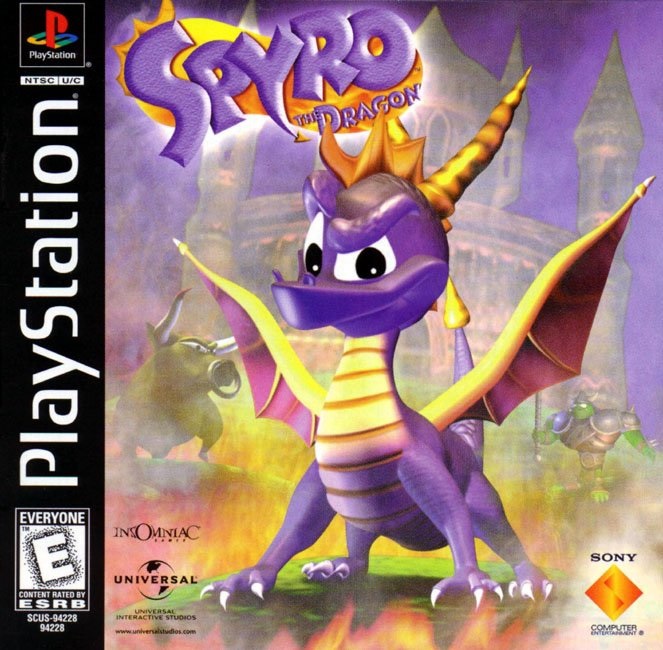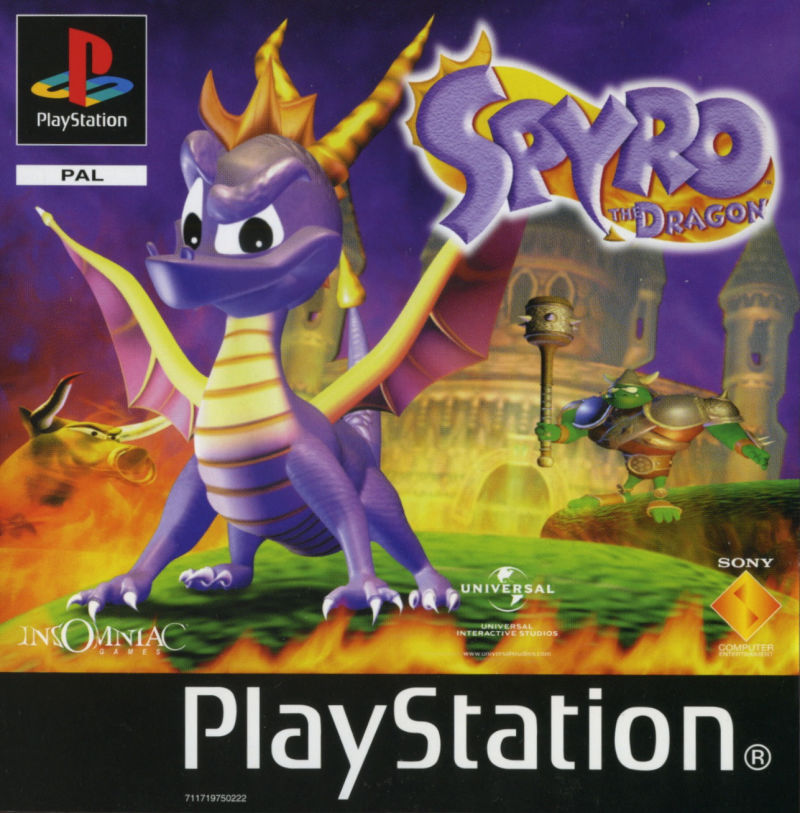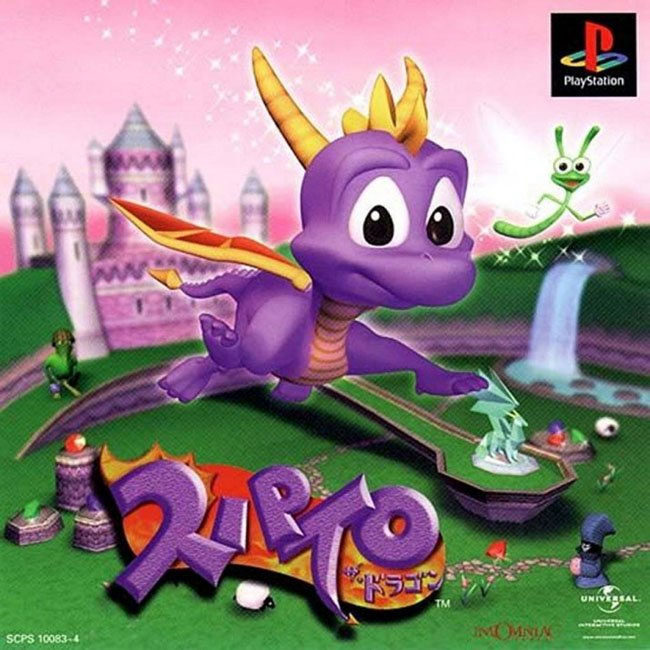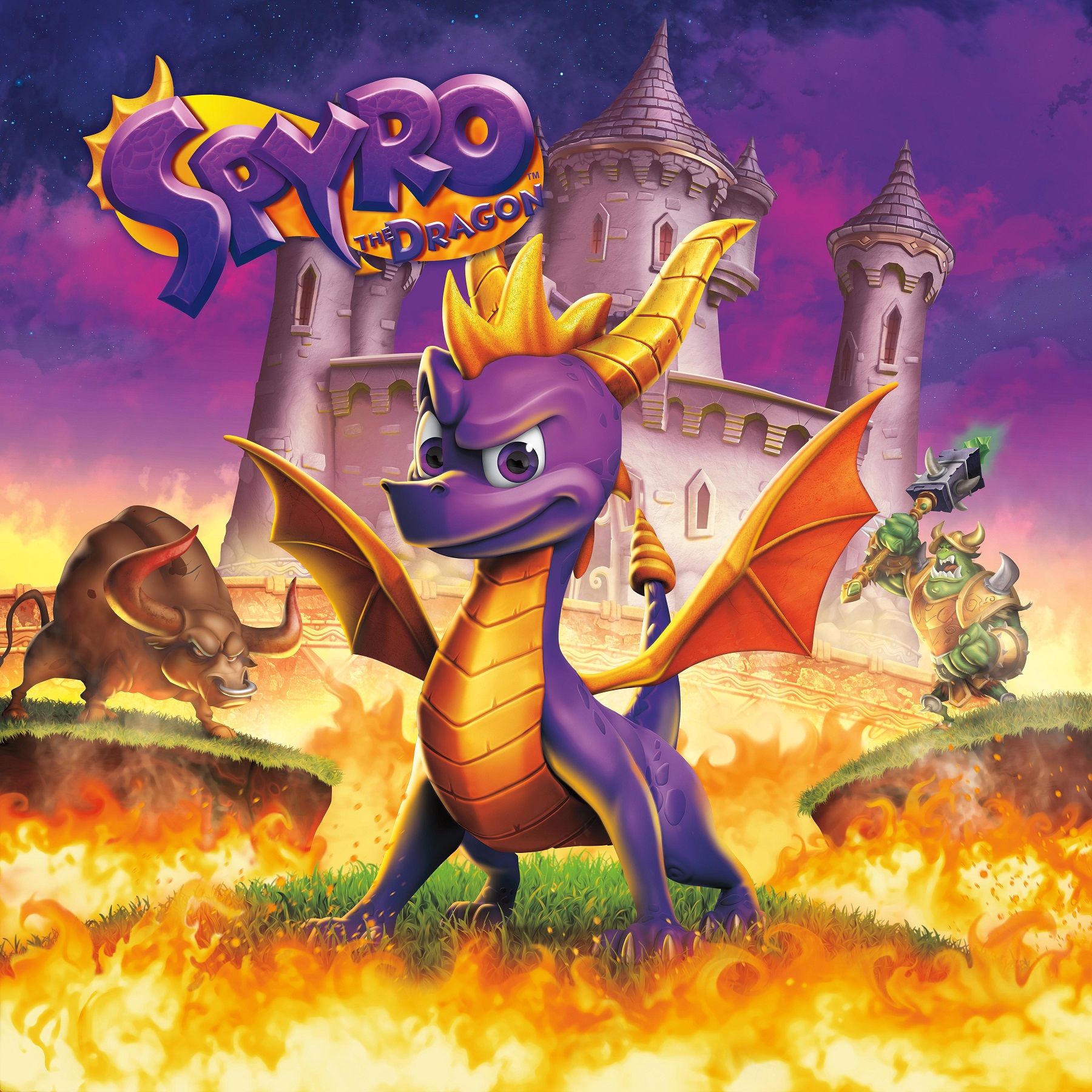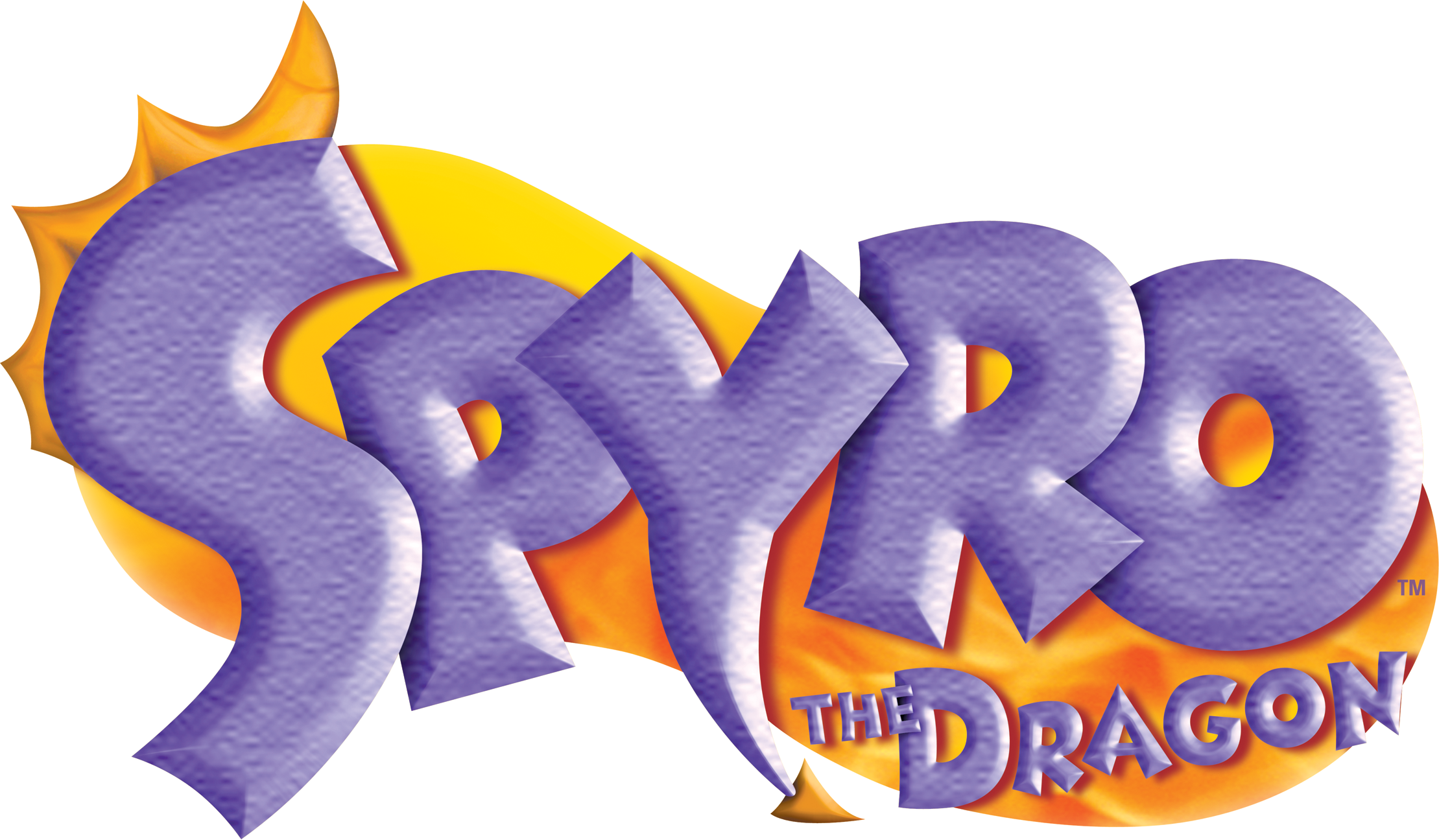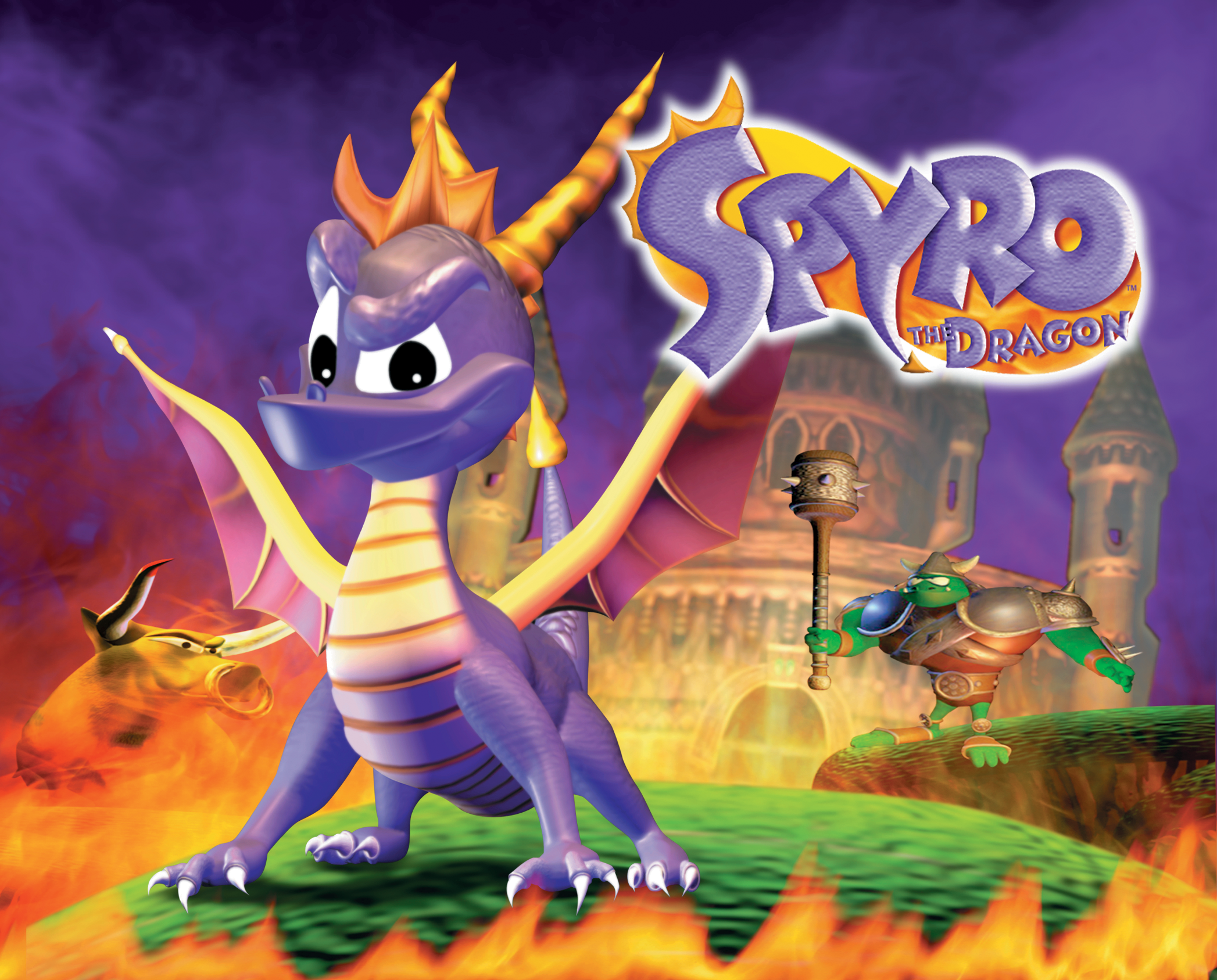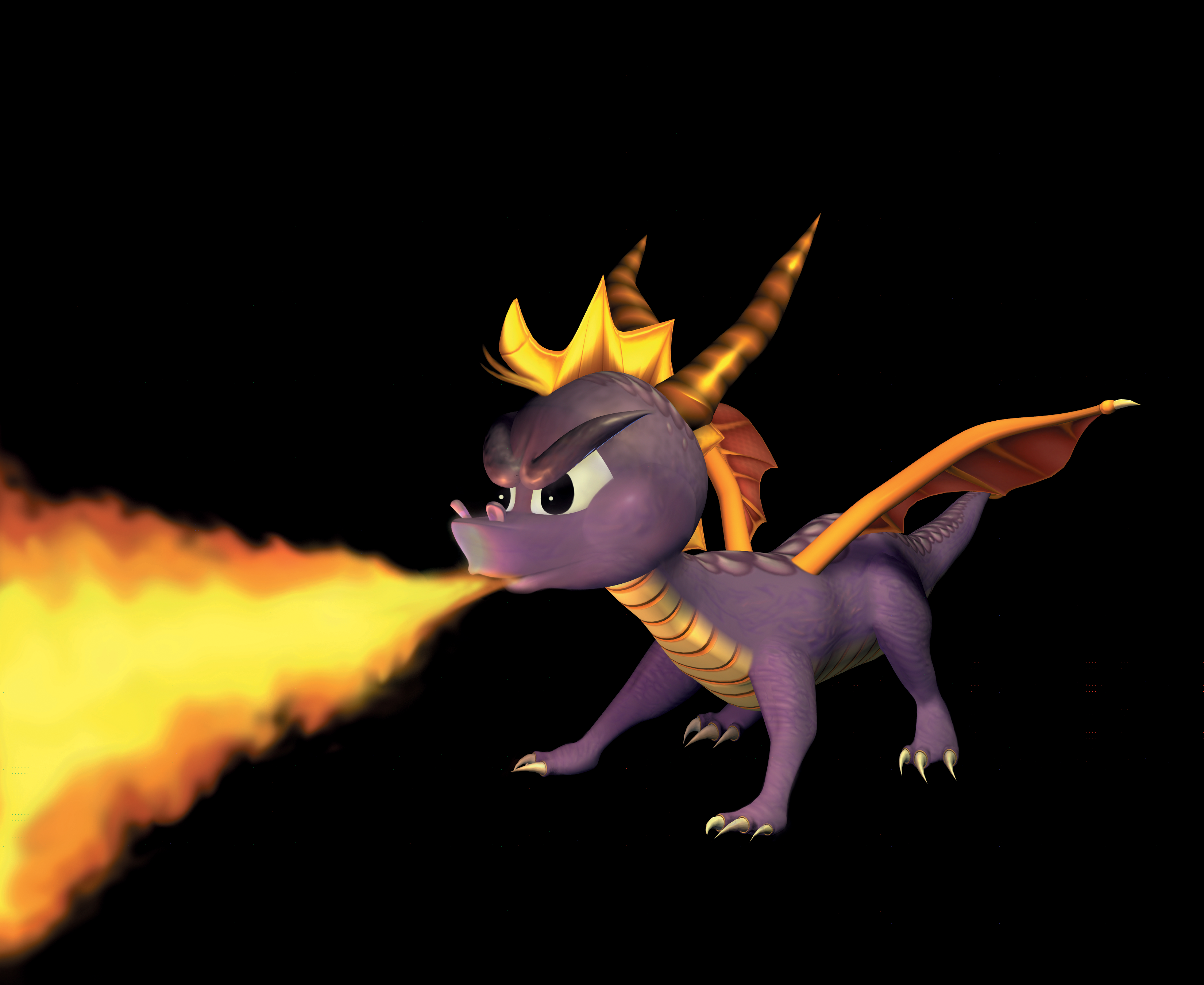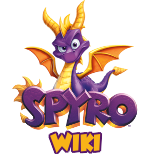Welcome to the Spyro Wiki's new home world!
Feel free to rewrite and expand the articles and upload images that are missing.
Spyro the Dragon (game)
- This article is about the first game of the Spyro franchise. For the main protagonist who has the same full name, see Spyro. For the mobile game, see Spyro the Dragon (mobile).
| Spyro the Dragon (game) | |||||
|---|---|---|---|---|---|
| Developer(s): | Insomniac Games | ||||
| Publisher(s): | Sony Computer Entertainment Universal Interactive Studios | ||||
| Producer(s): | Michael John | ||||
| Release date(s): | PlayStation: PlayStation Network: | ||||
| Genre(s): | Platformer | ||||
| Rating(s): |
| ||||
| Console(s): | PlayStation PlayStation 3 (PS One Classic) PSP (PS One Classic) | ||||
| Composer(s): | Stewart Copeland | ||||
| Mode(s): | Single player | ||||
| Input: | Controller (original release) | ||||
Spyro the Dragon is a platform video game developed by Insomniac Games. It was released at September 9th, 1998 in North America for the PlayStation. It stars the titular protagonist, Spyro, a young purple dragon saving the elder dragons, collecting gems, and defeating enemies. It is the first game in the Spyro the Dragon franchise.
On October 29, 2007, the game was made available for PlayStation 3, PSP and PS Vita in the PlayStation Store. Originally only in America and Japan, it has since been made available in Europe.
A complete remake of the game was released alongside Ripto's Rage! and Year of the Dragon as part of the Spyro Reignited Trilogy.
Summaries
- “Spyro the Dragon! Sparx the Dragonfly! And you! Together you can explore the five magical dragon kingdoms and save your dragon friends in this exciting new game for the Playstation game console.”
- – Spyro the Dragon website[4]
- “In the beginning, the five Dragon families lived in their five Dragon Worlds in harmony. Their lives were happy and peaceful... until the day a Gnorc broke the rules!
Gnasty Gnorc was an unpleasant creature from the bottom of his dirty boots to the top of his unwashed head. He wasn't pretty, and his personality combined the short temper of a gnome and the bad attitude of a orc!
Gnasty resented the happy Dragon families. More than anything, he detested their beautiful, shiny jewels, which were not only nice to look at, but showed him reflections of his own ugly mug every time he did so. Gnasty became such a problem that he was banished to the Dragon junkyard. This was a world the Dragons weren't fond of, though it suited Gnasty just fine. He renamed it Gnasty’s World as soon as he got there.
Gnasty began to fool around with magic spells. After a while, he hit on the two he wanted: a giant spell to trap all the Dragons in crystal, and a potion to animate those radiant gems and turn them into Gnorc soldiers.
On a nice sunny day, Gnasty crystallized all the Dragons then turned all the gems he could find into his willing minions. He even began turning the Dragon Worlds into Gnorc Worlds! But the one little detail he didn't count on was Spyro the Dragon. Spyro just happened to be playing hooky — again — and missed getting crystallized by Gnasty’s spell.
Now Spyro, the only unfrozen Dragon, must travel the six worlds — including Gnasty's industrial world — releasing all the Dragons and collecting their stolen treasure. In the meantime, Gnasty’s minions are doing their best to stop him. Not that Spyro is without friends... the Dragons he releases give him hints, and all along the way he is accompanied by Sparx the Dragonfly, his best friend.
What seems like a fun time flaming Gnorcs soon turned into the adventure of Spyro's young life. When he meets Gnasty Gnorc for the final conflict, his destiny can truly be fulfilled! Go get ‘em, Spyro!” - – Spyro the Dragon instruction manual[5]
Setting
The game takes place in the Dragon Realms, a sprawling world of much topographical and biological diversity, ornate structures and abundant treasure. It contains six Home Worlds, the first five of which are named after the dragon clan that resides there.
Spyro can navigate from one home world to another by completing a specific task given to him by one of the balloonists of that world. For example, collecting a certain number of gems or freeing a certain number of dragons will grant him access to the next world.
Each home world has its own set of realms which can be accessed via portals in archways scattered throughout the homeworld. Once in a realm, Spyro may return to the homeworld by finding and entering that realm's unique "Return Home" whirlwind platform or by pausing the game and selecting "Exit Level."
Story
In the Dragon Worlds, the elder dragons, Astor and Lindar, are being interviewed for a video documentary about their world. Meanwhile, the main antagonist, Gnasty Gnorc is watching the show. Long ago, Gnasty Gnorc detested the dragon families and their shiny jewelry and caused problems among them, so they banished him to the dragon junkyard.[6] During the show, a dragon calls Gnasty Gnorc simple-minded, a non-threat, and ugly. This angers Gnasty Gnorc, who casts a large magic spell to encase every dragon into a crystal, making them Crystal Dragons. He also makes a potion to turn the radiant gems into Gnorc soldiers to help him invade the Dragon Worlds and steal their treasure.
A young dragon named Spyro was not hit by Gnasty Gnorc's spell due to his small size.[7] Aided by his dragonfly companion, Sparx, Spyro eagerly starts his adventure to free the dragons and battle Gnasty Gnorc. Throughout his adventure, Spyro receives advice from the dragons that he frees.
After traveling through the first five Dragon Worlds, Spyro reaches the Dragon junkyard, which Gnasty Gnorc had renamed to Gnasty's World earlier on. Spyro manages to reach Gnasty Gnorc and defeat him in a final battle, therefore putting an end to Gnasty Gnorc's plot.
Gameplay
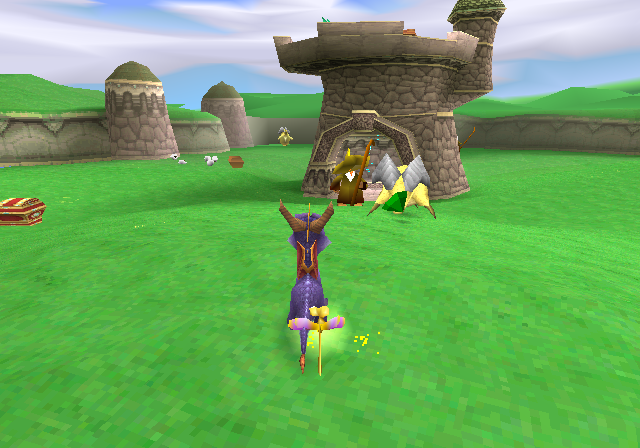
Spyro starts out in a Home World, which is a hub location that has portals leading to specific realms. When Spyro reaches the end of a realm, he can jump into the "Return Home" portal to return to the Home World. When Spyro has freed enough dragons or collected enough treasure, he can access the next world by talking to the nearby Balloonist in the hub world.
Every level has a few Crystal Dragons, each containing an imprisoned dragon. Spyro can free the dragon simply by touching the statue. Once the dragon is freed, it briefly talks to Spyro before disappearing. The statue's pedestal then becomes a save point and a checkpoint with the Red Fairy. There are a total of 80 Dragon Statues.
Spyro's two main abilities is breathing fire and gliding long distances in the air. Spyro can also perform a charge attack, where he headbutts into enemies using his horns. He can also break objects such as treasure chests this way. Each level is designed to incorporate Spyro's gliding ability, especially large gaps can only be crossed if Spyro jumps off higher terrain and starts to glide across. Some levels have small whirlwinds that launch Spyro a certain distance into the air, allowing him to reach higher areas or glide farther. Spyro cannot swim, so if he falls in the water, he quickly starts to sink and gradually loses hit points. If he is quick enough, Spyro can jump back on land. If Spyro loses all of his ha he loses all of his health.
Later levels feature supercharge ramps, which are stripes of hill marked with glowing arrows. When Spyro charges down a supercharge ramp, his speed increases significantly, allowing him to defeat powerful enemies or smash through certain walls. The speed ends once Spyro stops charging or crashes into an unbreakable wall. In some cases, the supercharge ramp can be combined to an upwards slope, allowing Spyro to perform a high-speed jump and cross very wide gaps.
Throughout the game, Spyro is accompanied by a small dragonfly named Sparx. Aside from helping Spyro collect nearby treasure, Sparx allows Spyro to take a few more hits. If Spyro is not accompanied by Sparx, he is instantly defeated after one hit. If Spyro accompanied by Sparx and takes damage from an enemy or obstacle, Sparx changes color to reflect Spyro's weakened condition. Sparx can take up to three hits before being defeated, and his color indicates how many health points Spyro has left: yellow represents full health, blue represents two hits remaining, and green represents one hit remaining. Sparx can regain a hit point if Spyro defeats a fodder, causing a butterfly to come out for Sparx to eat.
Controls
| Button | Movement |
|---|---|
| X | Jump |
| X + X | Glide |
| X + X + Δ | Stop in mid-flight |
| Hold Δ | Look around environment |
| O | Breath fire |
| □ | Charge |
| □ and X | Skip/Quick Charge |
| L2 or R2 | Move the camera |
| L1 or R1 | Dodge roll |
| START | Pause Menu |
| SELECT | View inventory |
Characters
- Spyro: The main and titular character of the game, Spyro goes on an adventure to rescue his friends and defeat Gnasty Gnorc.
- Sparx: Sparx is the best friend and protector of Spyro, and he allows Spyro to withstand a few more hits.
- Dragons: The main species and residents of Dragon World. Several dragons provide helpful advice to Spyro after he frees them from their crystal.
- Red Fairy: She appears at every pedestal where Spyro freed a dragon from its statue. Spyro has the option to either save his game progress or replay the dragon's message.
- Balloonists: They allow Spyro to travel between two Dragon Worlds.
Enemies
Most of the enemies are various types of Gnorcs. Spyro can defeat the weaker enemies by attacking them directly. Most of the enemies are invulnerable to a certain attack—enemies who carry a metal shield or wear plate armor are protected by Spyro's flames. They can usually be defeated from Spyro's charge attack. Contrarily, larger enemies can be defeated by Spyro's flame but not a charge attack. A few enemies are both large and metal-armored, which protects them from both of Spyro's attacks.
Species
- Fairies: In some levels, purple fairies kiss Spyro to improve his flame breath. In High Caves, there are fairies that prevent Spyro from falling into a pit, by lifting him back up on the ground.
- Fodder: While not enemies, fodder are various animals that Spyro can defeat to release a butterfly, which restores Sparx's health by a hit point. If Spyro is alone, he can defeat a fodder to bring back Sparx. Fodder consist of various animals, including sheep, frogs, chickens, rabbits, rats, bats, and lizards. There are also mushrooms, which are the only fodder that are not an animal, and Goat Sheep, which are the only fodder that are hybrid animals.
Bosses
Each world is overseen by an boss, who was put in charge of the Gnorcs or enemies in the area. While the portal to the boss's level is located near the Balloonist in each world, the player is not, in fact, required to confront and defeat the boss first. Rather, it is the Balloonist who sets the condition for traveling to the next world, and if Spyro has released enough dragons, collected enough treasure, the player may proceed to the next world without having to defeat the world's boss first.
| Name | Description |
|---|---|
| Toasty | He is the first boss and fought in Artisans. Toasty appears to be a scythe-wielding scarecrow but is ultimately revealed to be a sheep in disguise. |
| Doctor Shemp | Doctor Shemp is a witch doctor-like boss who wears sunglasses. He is the boss of Peace Keepers and the second boss overall. Doctor Shemp carries a skull-topped staff, which he tries to strike at Spyro. Doctor Shemp wears a metal shield to protect the front of his body, but is vulnerable from behind. |
| Blowhard | He is the third boss and is fought in Magic Crafters. Blowhard is a wind sorcerer with a whirlwind body and some facial features. Like the Green Wizards found throughout the level, Blowhard is also capable of generating thunderclouds and lightning bolts. |
| Metalhead | A large metal robot who is the boss of Beast Makers and the fourth boss overall. He attacks Spyro with electric energy rays and by throwing Armored Banana Boys and Strongarms. Metalhead is unaffected by Spyro's flame and charge attacks, but Spyro can defeat it by destroying the pylons powering him up. |
| Jacques | The boss of Dream Weavers and the fourth boss overall, Jacques is a lizard-faced jack-in-the-box, which its name was derived from. Jacques is located in a nightmare landscape filled with creatures born from bad dreams. Spyro fights him on a series of platforms levitating above a volcanic crater. His main attack is to throw boxes at Spyro. |
| Gnasty Gnorc | He is the main antagonist of the game and the final boss. Gnasty Gnorc's main attack is firing a green light from his scepter. The battle starts with Gnasty Gnorc standing on a platform that is out of Spyro's range of attack, so Spyro must obtain keys from thieves to lower the platform. Spyro must then chase Gnasty Gnorc through the junkyard until reaching a dead-end at the back of a magma-filled hallway, where he defeats Gnasty Gnorc. |
Items and objects
| Name | Description |
|---|---|
| 1-Up Chest | These are objects that contain a silver dragon statue, which grants an extra life to Crash if he collects it. |
| Dragon Egg | They are pink eggs that are stolen by thieves, and each one carries a Dragon Egg. There is a thief in most worlds and levels. Spyro is required to collect enough eggs to access Beast Makers world. |
| Gem | Also known as treasure, gems make up the hoard of the Dragon Treasure. Gems are scattered all over the Dragon Worlds due to Gnasty Gnorc's sloppy personality. Several gems are found in plain sight, some are found in treasure chests or pots, and some are found by defeating an enemy. Every level and world has a set number of gems, and collecting them adds to the game's completion percentage. Spyro must collect enough gems to access the last two worlds, Magic Crafters and Gnorc Gnexus.
Gems come in five colors—red, green, blue, gold, and purple—each representing 1, 2, 5, 10, and 25 respectively. Jewels with higher denominations are less common than the jewels with a lower one. There are a total of 14,000 jewels, several of which are found in Gnasty's Loot. |
| Life Sphere | If Spyro defeats an enemy more than once, it may drop an Life Sphere. When Spyro collects twenty of them, he receives an extra life. |
Deaths
Like most platformer games, there are nearly certain unfortunate events that can lead to Spyro's death. Sparx the Dragonfly follows Spyro around and indicates Spyro's health. Every time Spyro is hit, Sparx changes color:
| Color | Health Point |
|---|---|
| Yellow | 3 (Full health) |
| Blue | 2 |
| Green | 3 |
| None | 0 |
To replenish Sparx back to yellow, Spyro can defeat fodder, which will spawn a butterfly. Sparx will then eat it, causing him to regain one level of health. Small silver statues of a dragon can help back up extra lives (also known as 1UP's) that will revive Spyro. If Spyro dies, then don't fret! You will either go to the beginning of the level or the pedestal of the last saved dragon. If Spyro doesn't have any lives, Spyro will have to start the level over from the beginning of the world (in Beast Makers and Dream Weavers worlds; at any point Spyro is in a realm other than the home world, the starting point is right outside the entrance to a specific realm). Remember, Spyro may have more lives than a cat, but keep an eye on his life count. One wrong move could send you to the game over screen, where you will have to start the level you were on from the beginning.
Death Types
- Regular: If Spyro gets hit by a normal, heavy, or explosive attack, he will spin to face the player on two legs, lose his balance, and fall over backward.
- Flattened: If Spyro gets squashed flat by a slam attack of some sort, he will flip over and float down like a piece of paper. He will land gently on his back, still in his flattened state.
- Drowned: When Spyro falls into water, he splashes about and spits out water, desperately trying to prevent himself from drowning. When Spyro is completely submerged, he dies, but he can save himself by jumping out if he still has Sparx. However, it is instant death if the dragonfly is not present.
- Falling: Spyro will do his regular falling animation except for the fact he won't land. The screen will fade to black like all other death scenes.
Worlds
The game has six worlds, which are known as Dragon Worlds. Each world is home to a different type of dragon. They are where Spyro can access other levels by entering a portal. Every world has five portals except the last one, Gnorc Gnexus. Every world hub has some jewels, a few dragons to rescue, and a flight level that Spyro can unlock by performing a certain task within the hub.
The levels are similar to the worlds in that they have a certain number of gems and usually a few dragons to rescue. Every world except Gnorc Gnexus has three regular levels, a boss level, and a flight level. Every boss level has the same name its boss. Every level, including boss ones, can be completed in any order, although Spyro must unlock the flight levels from the world hub first.
The first five Dragon Worlds each have a flight level. As their name implies, flight levels involve Spyro gliding around the area, fulfilling certain tasks. They are the only levels with no dragons to rescue.
Music
The music for Spyro the Dragon was composed by Stewart Copeland, the drummer for The Police. The score for Spyro the Dragon was well received for its originality and portrayal of fantasy-like themes for the Dragon Worlds. All music was composed and performed on a keyboard inputted to a computer with software managing the recordings and compositions.[citation needed] The drum tracks were recordings of Copeland performing the actual drums. Every level in the game has a unique theme, except for Toasty and the Gnorc Gnexus world hub, which use the same theme. Like several video games, Spyro the Dragon's themes do not have any vocals, although the Wild Flight theme has obscured vocal-sounding voices layered on top of the guitar, organ and drums.
Regional differences
Music
In the North American release, the track for High Caves is a remix of Tree Tops's track. In the European release, High Caves was given a more upbeat track.
Japanese Port
In the Japanese ports of Spyro the Dragon, there were many issues that was the result of the game's localization. When the game was showcased to the Japanese public in 1998, there were numerous reports of headaches and "3D sickness" because the game was too fast, so changes had to be made in the game's localization. The changes included making the charging speed match the walking speed and the camera not follow behind Spyro.
Reception
According to Insomniac Games on the television series Icons, sales on Spyro the Dragon were initially slow at the game's launch but quickly picked up following the holiday season. In the week of November 29, 1998, it was the 3rd best-selling game in the UK, behind Tomb Raider and FIFA 99.[8] By December 1999, the game had sold a million copies in North America.[9]
The game was also praised for its tight control and highly memorable soundtrack. Although the game may be too easy for some, it is considered to be a great place to start in either the Spyro series or video games in general. GameSpot rated the game as 8.3, describing it as having very good graphics for its time, and being one of the first well-received full-3D platformers for the first PlayStation. IGN's Craig Harris hailed it as the most fun 3D platformer he had played since Crash Bandicoot, writing "Two claws up. Way up."[10]
Gallery
- For this subject's image gallery, see Spyro the Dragon (game)/Gallery.
-
Logo
-
Main artwork used for the game cover
-
Spyro using his flame breath
Trailers
Trivia
- Carlos Alazraqui, the voice actor for Spyro in the game, is also the voice of the chihuahua in the old Taco Bell commercials as well as Rocko from Rocko's Modern Life.
- Ex-Police drummer and co-founder Stewart Copeland composed the soundtrack of the game.
- Two Dragon families, the Machinists and the Aquifiers, were intended to be in the game, but were scrapped.[11]
- Clancy Brown, who voiced some of the dragons in the game, voices Mr. Eugene Krabs on SpongeBob SquarePants and played Captain Hadley on The Shawshank Redemption. Also, he was the voice of Dr. Neo Cortex and Uka Uka in the Crash Bandicoot franchise at the time of the game's release.
- On the old official website for the game’s Dragon News Network and the game’s instruction manual, there is an adult purple dragon. The DNN website refers to this dragon as “Papa Dragon”.[12]
- In this game, there are no female adult dragons because the lack of female voice actors, the limited hired voice cast and the lack of technical hardware that could allow differences between male and female dragons.[13]
- Within the game, there are six dragons from the five regular homeworlds that get rescued twice. This is because they went to confront Gnasty Gnorc, but failed. Despite rescuing a total of 80 dragons in-game, the fact that six of the dragons are rescued twice technically counts as 74 dragons (not including Spyro or the six free dragons being rescued a second time).
- Artisans and Gnorc Gnexus are the only Home World that block off the boss until a certain requirement is met.
- The only Boss Battle that is mandatory in this game is Gnasty Gnorc's. While the other bosses are optional, they are still required for 100% completion.
- Each of the flight realms features chests, excluding bonus level Gnasty's Loot.
- However, Gnasty's Loot does have normal chests.
- A few of the dragons share their names with the Dragon Elders from Spyro: A Hero's Tail, but they don't share the same origins and colors despite the implication that they might be the same characters.
- A dragon villager in Spyro: Shadow Legacy also shares a name with an Elder from this game, named Conan.
- Unlike the other games, pressing triangle causes Spyro to stop in midair while gliding. In future games, it gives him an extra boost in height.
- This is the only game in the series that features Spyro's stop, duck, and roll move.
- Although it was later removed in Ripto's Rage! and Year of the Dragon, it can now be performed in the remastered versions of those games in the Reignited Trilogy.
- Production of the game began shortly after the first Crash Bandicoot game was released.
- Ironically, Spyro the Dragon was initially released exactly 2 years after the initial release of Crash Bandicoot.
- The title screen in this game is the only one in the original trilogy that takes place at a point that can't be accessed in the actual game.
- The world, however, seems to be Magic Crafters, and Spyro knocks out a Common Gnorc, a non-violent enemy found in Artisan's home.
- During the development of the game, Spyro was originally going to be green. However, developers thought he would blend in with the grass, so they made him purple instead. Additionally, they did this to make him look different from traditional dragon designs.
- In 2002, the game was re-released, along with Spyro 2: Ripto's Rage! and Spyro: Year of the Dragon, as a collector's edition trilogy.
- Several early builds of the game have been released with a variety of differences from the final game.
- Two early demo builds were released on demo discs during the 90s. In these demos, only the Artisans home, Stone Hill and Dark Hollow are accessible, with the remaining levels being blocked off from the player. Of particular note in these versions is that Argus was removed from the Artisans home (presumably to avoid confusing the player) and all the artisans dragons feature different voice acting and dialogue. All dragons in the other Artisans realms display a text box with dialogue instead of using cutscenes.
- Three additional demos were also built after the final game's release. As a result, none of the differences in these demos are attributable to early builds of the game. In these demos, however, only Town Square and Sunny Flight are accessible, with Town Square being accessible through Stone Hill's portal, for some reason.
- A prototype dated June 15th 1998 was released in February 2020. Much of what is taken for granted in the final game is still incomplete in this version, and several levels are still in incredibly primitive stages of development.
- Another prototype also dated June 1998 was revealed in 2012, but has not yet been released. This prototype is somewhat more playable than the previous version, with all levels now featuring in-game, but there are still a wide variety of differences from the final game.
- A third prototype dated July 18th 1998 was released in March 2020. This build is fairly late in development with missing dragon cutscenes being the main notable difference, though of particular note is an earlier name for Gnasty's Loot - "Gnasty Booty".
- A localization prototype dated August 27th 1998 was originally released under the belief it was a final version of the game in around 2007. After being re-discovered and recovered many years later, it was released in March 2020. Unlike the other prototypes this build is from after the final NTSC-U version of the game but still before the final PAL version, meaning that there are a number of differences in the game's translation and in areas that changed between the NTSC-U and PAL final releases.
- Two early demo builds were released on demo discs during the 90s. In these demos, only the Artisans home, Stone Hill and Dark Hollow are accessible, with the remaining levels being blocked off from the player. Of particular note in these versions is that Argus was removed from the Artisans home (presumably to avoid confusing the player) and all the artisans dragons feature different voice acting and dialogue. All dragons in the other Artisans realms display a text box with dialogue instead of using cutscenes.
- This is the only Spyro game to have Spyro's tail spike on the "Y" in the logo rather than the "S."
- In the Japanese version, you can access one of the Pocket Station Mini Games if you plug in the Pocket Station accessory. In the minigame, you train your very own dragonfly.
- Spyro's Japanese voice was done by a female actress named Akiko Yajima, who did the original voice for Shinnosuke Nohara from Crayon Shin-chan.
- At the beginning of the Japanese game, there are signs scattered across the level, which are typically instructions on how to control Spyro.
- At the end of the credits, it says "No sheep were harmed during the creation of this game. A few gnorcs, but no sheep." This is a most likely nod to the commercials for the game, where a disgruntled sheep was protesting the game for Spyro's supposed violence towards sheep.
- The home-worlds may be based off the Hindu caste system. Early, lower levels are based on artisans, while spiritual people (dream weavers) are higher. Warriors (beast makers) can be found in the middle.
- The Japanese version of the game was released on April 1, 1999, seven months after the North American release. The Japanese release was delayed because of massive localization for the Japanese market.
- In the European PlayStation Store, the game has been released to the NTSC version. This is due to the glitches with the PAL releases, as explained here.
- At the title screen, if you press L1 and Triangle on your PlayStation controller, you can access a secret demo to Crash Bandicoot: Warped.
- It also works vice-versa if you press Up, Up, Down, Down, Left, Right, Left, Right and Square at the title screen for Warped.
References
- ↑ transcript of the Universal Chat with Insomniac Games. (Date Posted - Sept. 11, 1998). Spyro the Dragon (1998).
- ↑ a b Spyro the Dragon UK website - www.spyro1.com (archived)
- ↑ PlayStation Store
- ↑ Spyro the Dragon website - archived
- ↑ Spyro the Dragon instruction manual - archived
- ↑ Spyro the Dragon manual, page 6.
- ↑ Spyro the Dragon Europe Press Brochure
- ↑ UK Top Ten - Here are the top selling games for all you European readers out there.. (Date Posted - Jun 21, 2012). IGN.
- ↑ Cool Consumer Promotions Support Launch of Highly Anticipated Spyro -2- : Ripto's Rage!. (Date Posted - Dec. 3, 1999). Business Wire.
- ↑ Spyro the Dragon - This dragon may be small, but he sure is big on action. (Date Posted - Dec 12, 2018). IGN.
- ↑ Spyro the Dragon Press Kit Archive
- ↑ Dragon News Network - archived
- ↑ 10 Spyro Facts That YOU NEVER KNEW! Ft. Oliver Wade. (Date Posted - Mar. 4, 2021). YouTube.
External links
- North American website (archived)
- European website (archived)
- PlayStation.com website (archived)
